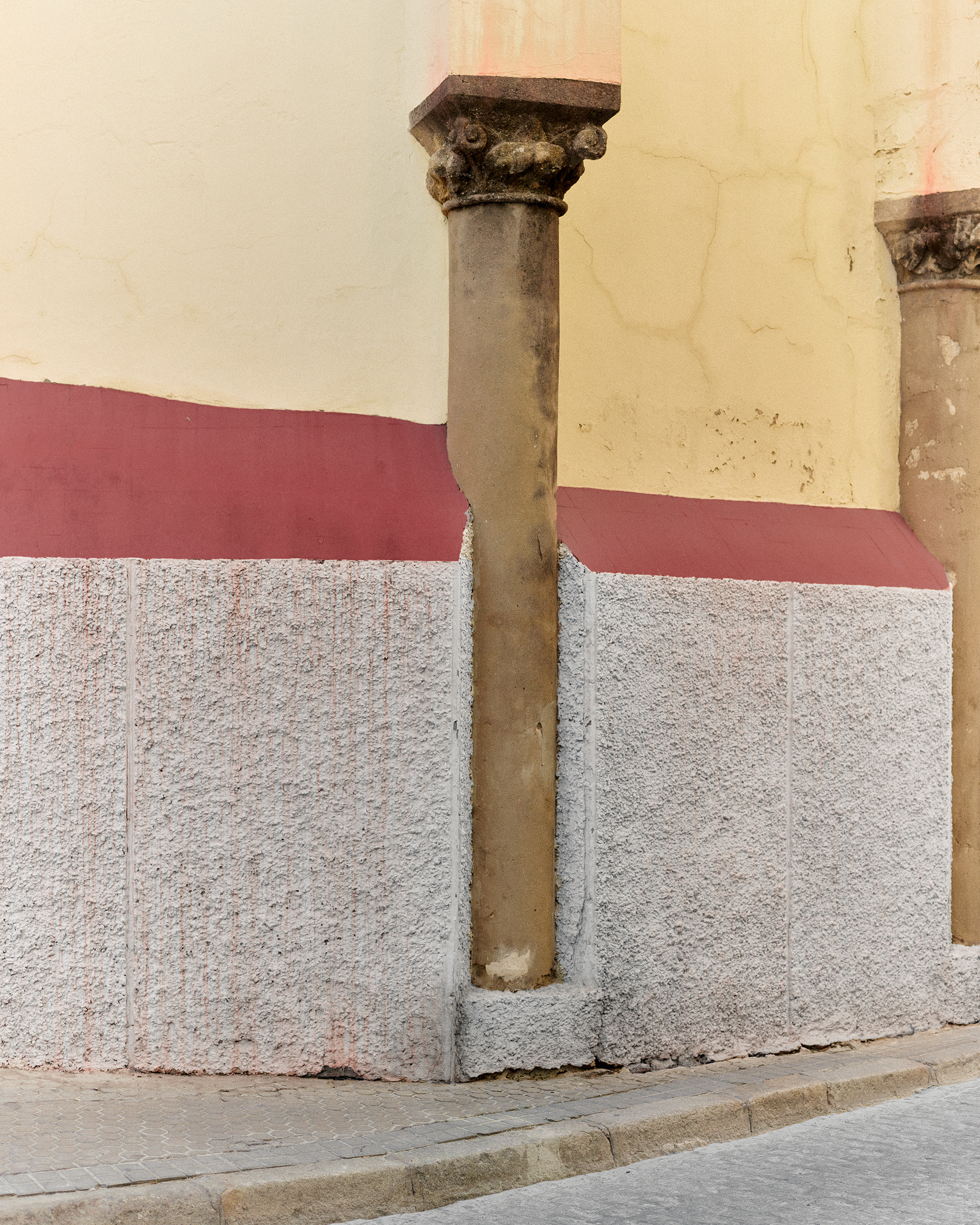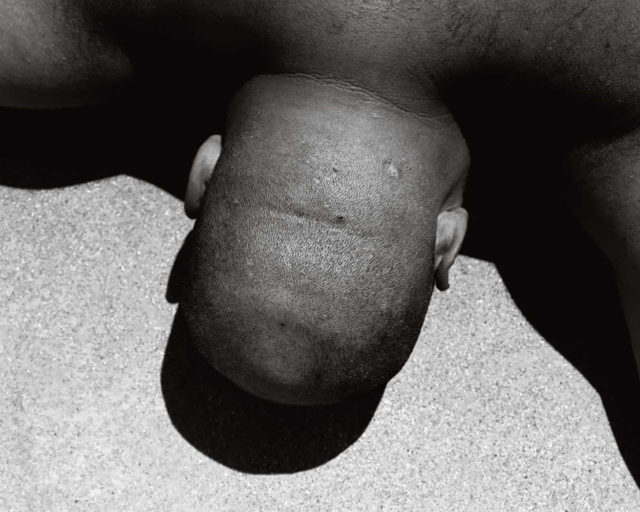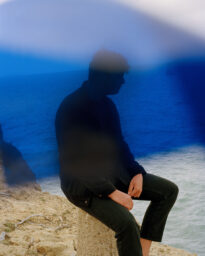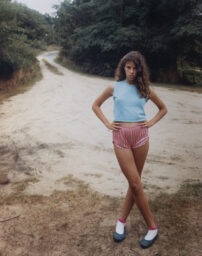Felipe Romero Beltrán Chronicles the Experiences of Young Immigrant Men in Spain
Winner of the 2022 Aperture Portfolio Prize, the Colombian photographer collaborates with young men living in legal limbo, creating evocative images about dreams and memory.
Felipe Romero Beltrán, Bilal’s body is carried by his friends after a fainting episode, from the series Dialect, Seville, 2020–22
The southern Spanish city of Seville offers an utterly excessive amalgamation of Moorish architecture, Gothic iconography, and enough religious fervor to put a saint (or a saint’s name) on nearly every corner. In the photographs of Felipe Romero Beltrán, those details of historical layers and visual textures appear muted and subdued, distilled down to the corner of a bright yellow wall, an old column swallowed by concrete, or the mere glimpse of intricate woodwork on a heavy door. For a few years now, Romero Beltrán has been working on a series of images and related videos, titled Dialect (2020–ongoing), delving into the routines, memories, and experiences of a small group of young immigrants who crossed into Spain from Morocco as minors and are living in a refuge center, awaiting the normalization of their legal status.
The photographs include ruminative still lifes (blackened tomatoes, dried leaves on a table) and architectural curios (a painted-over pattern of bricks, resonant place names like Abu Yacub) as well as lively portraits of the young men (Youssef Elhafidi, Hamza Gharnili, and Bilal Siasse, among others) who appear, by turns, bored, exuberant, and reflective of their circumstances. The videos, more didactic in nature, document the palpable struggle that Romero Beltrán’s subjects endure when they try to read aloud from the first few pages of Spain’s immigration law, the prose leaden and opaque in any language. The remarkable sensitivity with which Romero Beltrán captures the lives of these young men—enmeshed as they are in the structures of the refuge center, the city of Seville, and the wider politicization of illegal migration to Spain—may have something to do with his own path, often precarious, from South America to Europe via a major detour to the Middle East.


It’s not that you can adequately compare the Colombian civil war to the Palestinian-Israeli conflict and say that one is more dangerous than the other. It’s just that if you grew up accustomed to the forms of violence exchanged between, say, far-right paramilitaries and the left-wing militant group FARC, then you might not necessarily experience fear or even trepidation as an initial response to the idea of studying at a storied art school in Jerusalem. That’s how it was for Romero Beltrán, who was born and raised in Bogotá, arrived at the Bezalel Academy of Arts and Design in 2014, and spent a year and half there taking quizzical black-and-white pictures of blocked streets and barricaded houses in the middle of a territorial (and existential) struggle whose contours shifted without warning on a nearly daily basis.
West Bank (2014), the project that Romero Beltrán embarked on during his time at Bezalel, detailing the brutality and absurdity of imposing borderlines in labyrinthine urban environments, may not have been the work that catapulted him to international attention, but it did mark a crucial turning point. After Jerusalem, Romero Beltrán’s formidable training in classical documentary photography—which began at the Motivarte School of Photography, in Buenos Aires, a crucible of Argentinean photojournalism, and continues in Madrid, where he is currently writing a dissertation on the documentary tradition—expanded outward to embrace elements of performance and conceptual art. Dialect, with its insistence on complexity, theatrics, and mystery, has less in common with photojournalistic projects on asylum and illegal migration into Europe than it does with critical and philosophical inquiries such as Yto Barrada’s A Life Full of Holes: The Strait Project (1998–2004), Hassan Khan’s video installation Jewel (2010), and Bouchra Khalili’s The Mapping Journey Project (2008–11), all of which predate the current refugee crisis by several years.

Romero Beltrán first met the subjects of Dialect during a theater workshop, part of a project on inclusion, organized by the mother of his then girlfriend, now fiancée. His soon-to-be mother-in-law invited Romero Beltrán to speak with the group about his own experience as a migrant in Spain. Learning he was a photographer, some of the participants asked him to take a few pictures that they could use on social media and send home to their families. The boys were all teenagers at the time. Romero Beltrán’s collaboration with them evolved into an artwork as they entered adulthood.
Rather than presenting types, tropes, or tragic cases, Romero Beltrán’s images introduce viewers to the humorous quirks and wondrous specificities of Youssef, Hamza, Bilal, and other young men, named and almost knowable characters who, moreover, have a say in how the work is made and shown. Romero Beltrán always photographs with a digital camera and shares his pictures with his subjects. If they don’t like them, he trashes them. The ethics of how they work together are dynamic and sometimes complicated. But in a world flooded with depictions of atrocity, they are sound.
The sensitivity with which Romero Beltrán captures the lives of these young men may have something to do with his own path from South America to Europe.
Romero Beltrán’s series has grown beyond documentary to include staged pictures not only of images that the young men didn’t like and decided to repeat, but also of their past experiences, their dreams. One of the most striking photographs in the series shows the body of Bilal draped over the shoulders of two friends reenacting a moment when Bilal fainted during his journey from Tangier to Seville. Dialect has given its subjects a chance to relive some of the more difficult moments in their young lives, and, in doing so, in remaking the droop of a young man’s hips, the fall of his arm, the sight of his worried brow smoothing out, transform those moments into gestures of real beauty, of tension being poetically undone by novel forms of collective support.



All photographs courtesy the artist
Felipe Romero Beltrán is the winner of the 2022 Aperture Portfolio Prize. His solo exhibition of Dialect will be on view at Baxter St at the Camera Club of New York in summer 2022.
This piece appears in Aperture, issue 247, “Sleepwalking,” under the column “Spotlight.”


























